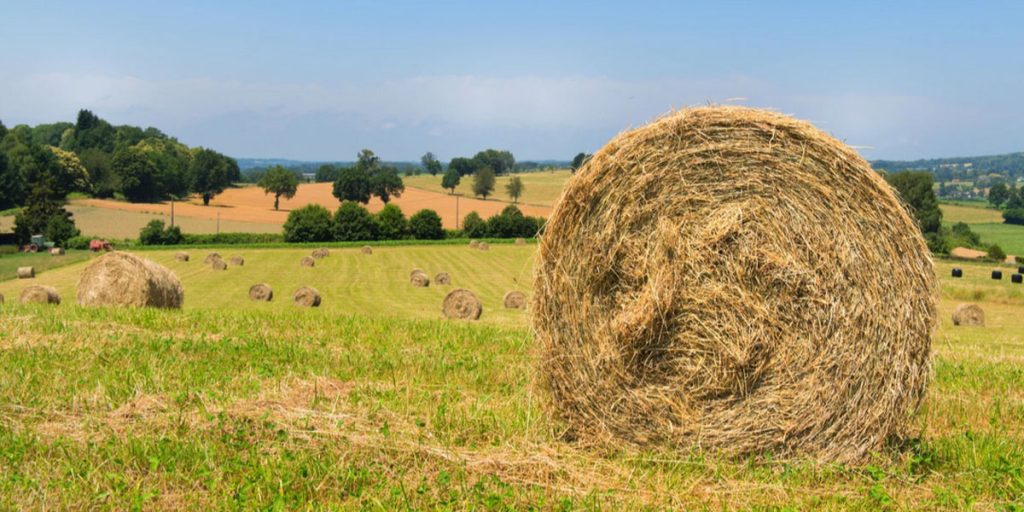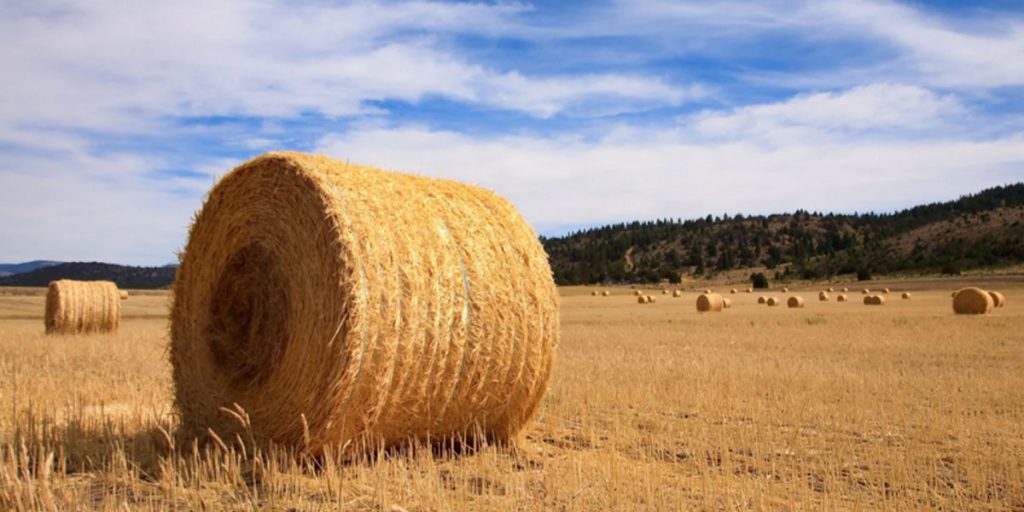A round bale of hay typically weighs between 500 to 1,500 pounds. The weight can vary based on size, density, and moisture content.
Understanding the weight of a round bale of hay is crucial for transport, storage, and feed planning.
Hay bales come in various sizes, which directly impact their weight. Farmers and livestock owners prioritize this information to manage their resources effectively and ensure their machinery can handle the load.
Bale weight also affects nutritional planning for animals, as different weights provide varying amounts of feed.
The weight can be influenced by the type of hay, as alfalfa bales often differ from grass hay bales.
Proper knowledge of a hay bale’s weight aids in efficient farm management and helps avoid unnecessary strain on equipment, leading to a smoother operation in agricultural practices.

Weight Range Of Round Hay Bales
Understanding the weight of round hay bales is crucial for farmers and transporters. As they come in various sizes, the weight range can vary significantly.
Factors Influencing Hay Bale Weight
Multiple factors impact the weight of a hay bale.
- Moisture Content: Wet bales weigh more.
- Hay Type: Different plants weigh differently.
- Bale Size: Larger bales are heavier.
- Baling Pressure: Tightly pressed bales weigh more.
Average Measurements And Weights
The size and weight of hay bales are often related.
| Bale Diameter | Bale Weight |
|---|---|
| 4 feet | 400 to 600 lbs |
| 5 feet | 800 to 1,200 lbs |
| 6 feet | 1,000 to 1,600 lbs |
The average round hay bale is 5 feet wide and weighs between 800 to 1,200 pounds.
Baling Process And Its Impact On Weight

The baling process significantly influences how much a round bale of hay weighs. Hay baling involves compressing and wrapping grass into compact, easy-to-handle rolls.
The equipment and steps used in this process can affect the final weight of each bale.
Steps In Forming A Round Bale
- Cutting: The hay gets cut when it reaches the ideal moisture level.
- Drying: Cut hay dries in the field to reduce moisture content.
- Raking: Farmers rake hay into rows to prepare for baling.
- Baling: Equipment gathers the hay, rolling it into a cylindrical shape.
- Binding: The rolled hay is then wrapped with netting or twine.
- Ejection: The completed round bale is ejected from the baler onto the field.
Equipment Used For Baling
- Mower: Cuts the hay down to a uniform size.
- Tedder: Spreads the hay out to dry.
- Rake: Gathers the hay into rows.
- Round Baler: Rolls the hay into a bale and binds it.
- Tractor: Provides the power to operate the baler.
The bale’s weight depends on various factors. These include hay density, moisture content, bale size, and type of hay.
All these aspects result from the baling equipment’s efficiency and the process overall.
Common Uses Of Round Hay Bales
Round hay bales are not just for feeding animals. People use them for other important things. Let’s find out how they help in different ways.
Feeding Livestock
Animals on farms eat hay from these round bales. It is like a big meal for them. Farmers feed cows, horses, and sheep with them.
It is easy because the bales are big and last a long time.
Erosion Control And Landscaping
Round hay bales help the land in two ways. They stop dirt from washing away when it rains. They also make gardens look nice.
People use hay to cover seeds. It keeps the seeds safe until they grow into plants.
Here is a list of how round bales can be used:
- Feeding different types of farm animals
- Stopping soil from eroding
- Helping seeds grow in gardens
- Making outdoor places look better
Transporting And Handling Round Bales

Handling round bales requires strength and strategy. With round bales often weighing in at 500 to 1,500 pounds, moving them is no small feat.
Discover the best ways to transport these hefty items efficiently and safely.
Methods Of Moving Hay Bales
Knowing the right techniques makes moving bales easier. Here are several methods:
- Tractors: Most farmers use tractors with spike or grabber attachments.
- Skid steers: Skid steers can maneuver in tight spaces, perfect for smaller farms.
- Hay Lifts: Specialized equipment that can stack bales higher.
- Manual Handling: For the smallest bales, a pair of strong arms might do.
Safety Considerations
Transporting round bales requires a focus on safety. Here are key points:
- Always keep bales stable and secured during transport.
- Use the right equipment suited to the bale’s size and weight.
- Train all individuals in proper lifting techniques to prevent injuries.
- Ensure clear communication when working in teams.
Storage Solutions For Round Hay Bales
Whether you’re a seasoned farmer or a hobbyist with a knack for countryside living, storing your round bales of hay is as crucial as its harvest.
Proper storage solutions not only protect your bales from the elements but also preserve their quality.
This guide will uncover the top storage tactics to ensure your hay remains fresh and nutritious for your animals.
Indoor Vs. Outdoor Storage
Choosing the right storage for your hay bales can make a significant difference in their longevity. Let’s compare two popular methods:
- Indoor Storage: Storing hay indoors significantly reduces the risk of moisture damage and maintains nutritional value.
- Outdoor Storage: It’s cost-effective but requires careful placement and covers to protect against weather.
In indoor settings, keep hay off the ground using pallets. This prevents moisture from seeping in.
Outdoor bales benefit from being tarped and positioned on a slight slope for water runoff. Regardless of the choice, ensure good air circulation around each bale.
Maximizing Shelf Life Of Hay
For hay to serve its purpose well beyond the harvest season, certain practices are essential. Below are key strategies to maximize the shelf life:
| Action | Benefit |
|---|---|
| Use Covers | Prevent water and sun damage. |
| Maintain Proper Spacing | Allow airflow to reduce spoilage. |
| Keep on Elevated Surfaces | Avoid ground moisture. |
| Inspect Regularly | Early detection of mold or pests. |
Employing these methods will ensure your round bales of hay remain in top condition for your livestock.
Remember, the weight of a round bale may range from 500 to 2,500 pounds, depending on size and density.
Thus, durability and accessibility should be top of mind when designing your storage solution.
Variations In Hay Quality And Density
The weight of a round bale of hay can differ greatly. This variation often comes down to the hay’s quality and density.
Not all hay is the same. Different types have unique densities. This affects how heavy a bale becomes.
Moisture content also plays a key role. Too much moisture can increase weight. But it can cause other issues like mold. A balance is essential for a good quality bale.
Types Of Hay And Their Densities
Different hay types have varying densities. This impacts their weight. Bold Alfalfa, for instance, is denser than grass hay. Other factors include how tightly the hay is packed.
| Type of Hay | Average Density |
|---|---|
| Alfalfa | High |
| Timothy | Medium |
| Orchard | Medium |
| Bermuda | Low to Medium |
| Clover | Medium to High |
Effects Of Moisture Content On Weight
Moisture content plays a crucial role in the weight of hay bales. Dry hay is lighter. Wet hay is heavier but can lead to spoilage.
A bale should have less than 15% moisture for safe storage. Bales with higher moisture may weigh more. But they pose a risk of molding or even spontaneous combustion.
- Ideal moisture levels keep bales safe and at the right weight.
- Hay with too much moisture can weigh significantly more.
- This can lead to higher transportation costs and storage issues.
FAQs About the Weight of a Round Bale of Hay
What Is The Average Weight Of A Round Hay Bale?
The average weight of a round bale of hay typically ranges from 400 to 2,500 pounds. The exact weight depends on the size, density, and moisture content of the bale, as well as the type of hay.
How Does Hay Type Affect Bale Weight?
Different types of hay, such as alfalfa, timothy, or clover, have varying densities that influence the weight of a bale. Alfalfa, for instance, is generally denser and therefore produces heavier bales than grass hays.
Can Bale Size Impact Its Weight Significantly?
Yes, bale size greatly impacts weight. Standard round bales usually measure around 4 to 6 feet in diameter and the larger the bale, the heavier it will be.
Why Is Knowing A Hay Bale’s Weight Important?
Knowing the weight of a hay bale is crucial for proper transportation planning, storage management, and livestock feeding schedules, ensuring safety and efficiency.
Conclusion
Navigating the nuances of agricultural operations is crucial. Knowing the weight of a round bale of hay is essential for farmers and transporters alike.
Typical weights vary from 500 to 1500 pounds, influenced by moisture content and bale size.
Efficient farm management embraces such details, ensuring smooth logistical planning and healthy livestock feeding regimens.
Keep in mind these variables for a successful hay handling experience.
Resources:
https://extension.psu.edu/keeping-an-eye-on-stored-hay-temperatures
https://www.epa.gov/system/files/documents/2021-11/bmp-straw-or-hay-bales.pdf
